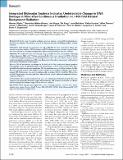Integrated Molecular Analysis Indicates Undetectable Change in DNA Damage in Mice after Continuous Irradiation at ~ 400-fold Natural Background Radiation
Author(s)
Olipitz, Werner; Shuga, Joe; Pang, Bo; McFaline, Jose Luis; Lonkar, Pallavi; Thomas, Aline; Mutamba, James Tendai; Greenberger, Joel S.; Samson, Leona D.; Dedon, Peter C.; Yanch, Jacquelyn C.; Engelward, Bevin P.; Wiktor-Brown, Dominika; ... Show more Show less
DownloadDedon_Integrated Molecular.pdf (499.5Kb)
PUBLISHER_POLICY
Publisher Policy
Article is made available in accordance with the publisher's policy and may be subject to US copyright law. Please refer to the publisher's site for terms of use.
Terms of use
Metadata
Show full item recordAbstract
Background: In the event of a nuclear accident, people are exposed to elevated levels of continuous low dose-rate radiation. Nevertheless, most of the literature describes the biological effects of acute radiation.
Objectives: DNA damage and mutations are well established for their carcinogenic effects. We assessed several key markers of DNA damage and DNA damage responses in mice exposed to low dose-rate radiation to reveal potential genotoxic effects associated with low dose-rate radiation.
Methods: We studied low dose-rate radiation using a variable low dose-rate irradiator consisting of flood phantoms filled with 125Iodine-containing buffer. Mice were exposed to 0.0002 cGy/min (~ 400-fold background radiation) continuously over 5 weeks. We assessed base lesions, micronuclei, homologous recombination (HR; using fluorescent yellow direct repeat mice), and transcript levels for several radiation-sensitive genes.
Results: We did not observe any changes in the levels of the DNA nucleobase damage products hypoxanthine, 8-oxo-7,8-dihydroguanine, 1,N6-ethenoadenine, or 3,N4-ethenocytosine above background levels under low dose-rate conditions. The micronucleus assay revealed no evidence that low dose-rate radiation induced DNA fragmentation, and there was no evidence of double strand break–induced HR. Furthermore, low dose-rate radiation did not induce Cdkn1a, Gadd45a, Mdm2, Atm, or Dbd2. Importantly, the same total dose, when delivered acutely, induced micronuclei and transcriptional responses.
Conclusions: These results demonstrate in an in vivo animal model that lowering the dose-rate suppresses the potentially deleterious impact of radiation and calls attention to the need for a deeper understanding of the biological impact of low dose-rate radiation.
Date issued
2012-04Department
Massachusetts Institute of Technology. Center for Environmental Health Sciences; Massachusetts Institute of Technology. Department of Biological Engineering; Massachusetts Institute of Technology. Department of Biology; Massachusetts Institute of Technology. Department of Nuclear Science and EngineeringJournal
Environmental Health Perspectives
Publisher
National Center for Biotechnology Information
Citation
Olipitz, Werner et al. “Integrated Molecular Analysis Indicates Undetectable Change in DNA Damage in Mice After Continuous Irradiation at ~ 400-fold Natural Background Radiation.” Environmental Health Perspectives 120.8 (2012): 1130–1136. Web.
Version: Final published version
ISSN
0091-6765
1552-9924